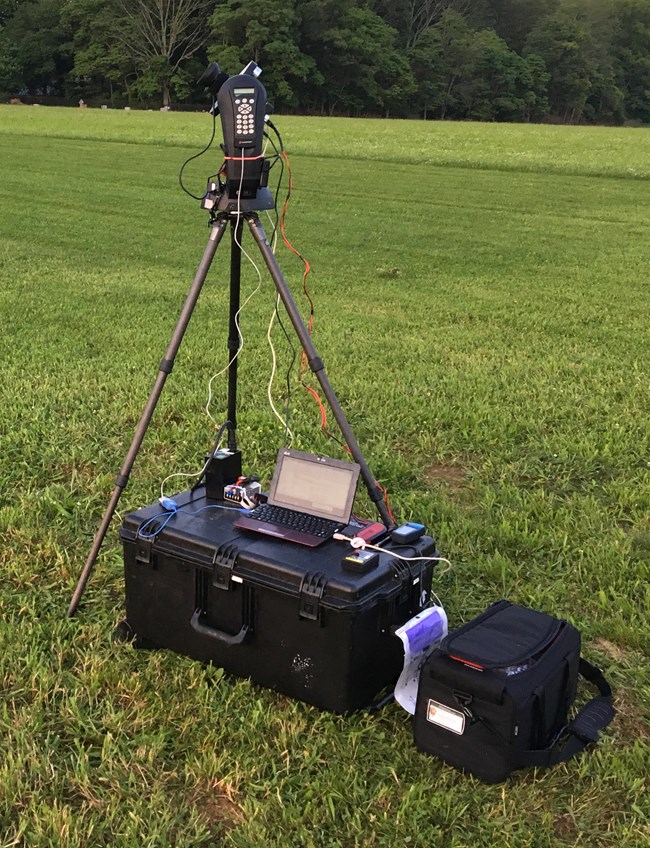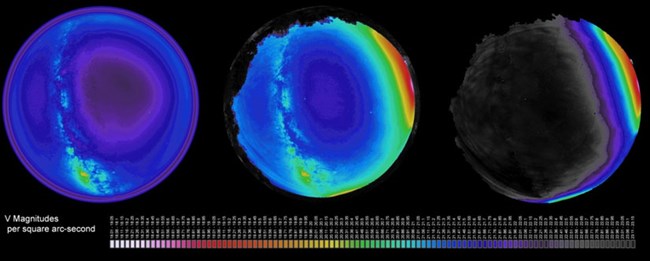
NPS
Capturing the essence of a lightscape with numerical data is complex, but advances in technology have made possible an efficient and accurate method of measuring the impact of light pollution. The National Park Service has pioneered portable instrumentation and techniques for measuring conditions in parks and since 2001 has been testing and capturing data in nearly 100 national parks. The current state of the methodology features:
-
Rapid capturing the night sky in a high resolution mosaic
-
Precise measurement of sky brightness and glare across the entire celestial hemisphere
-
Identification of light pollution sources, and
-
Separation of natural and human-caused sky brightness.
The approach is designed to measure the night sky as the human eye sees it; in doing so, we can quantify aspects of the natural lightscape.
The heart of the system is a CCD camera (charged coupled device camera)—essentially a research-grade digital camera. It is attached to a robotic mount and laptop computer. The computer choreographs the entire system, pointing the camera to pre-determined areas of the sky and capturing a series of short exposures. These images are later individually calibrated and then stitched together to form a mosaic of the entire sky that can be displayed in either a panoramic or hemispheric (i.e., fish-eye) view. Data are calibrated to stars of known brightness, allowing absolute brightness measures to be extracted from the images. The camera uses a green filter, rejecting all other light from the infrared to the ultraviolet. This green or "V-band" filter approximates human night vision sensitivity. This process is known asastronomical photometry.
Data is displayed in various measures of sky brightness (luminance) as well as ground illuminance as a result of human-caused light.

NPS / Palomar Observatory (California Institute of Technology)

NPS
Measurement Conditions
Sites are selected that have a good view of the horizon with minimal obstructions. Small parks generally have one representative data site, whereas large parks may have several. Data are collected for 1–8 hours per night, and often on multiple nights. Weather conditions constrain data collection, as it has to be at least 95 percent clear to capture sky brightness conditions properly. Only nights with no moon are suitable. In addition to the photometric measures, field technicians make observations of the nighttime environment and sky quality. This enables the NPS to identify relationships between numerical data and visual features of the night and better understand human visual perception of the natural lightscape.
The NPS methods for night sky measurement provide park managers with scientifically sound information from which to understand the quality of their natural lightscape and the threats to it. The core of our methods have been peer-reviewed and published (Duriscoe, 2007). Additional technical advancements are currently being tested and will receive the same level of scrutiny. To date, nearly 100 NPS sites have been surveyed. This represents a substantial baseline inventory of conditions at parks across the United States. The NPS is also working toward synthesizing this data into simplified products to better inform park managers and the public.
Future extensions of the methodology may include development of a long-term monitoring program and measuring the sky in different spectra (colors) to provide a better understanding of ecological impact.
References
Duriscoe D., Luginbuhl C., and Moore C. 2007. Measuring Night Sky Brightness with a Wide-Field CCD Camera. Publications of the Astronomical Society of the Pacific, Vol 119.
Last updated: July 3, 2018
